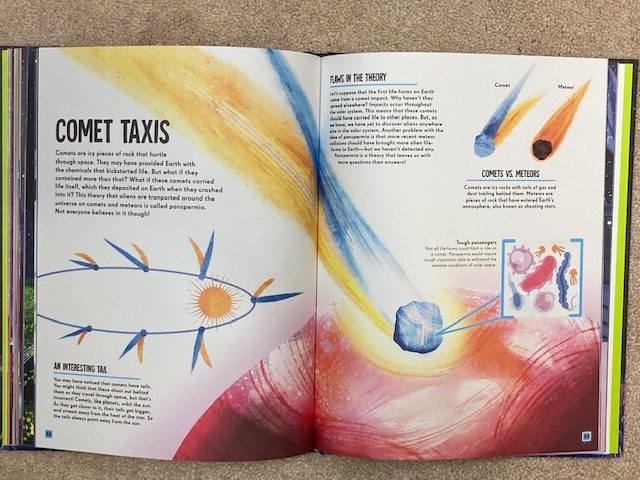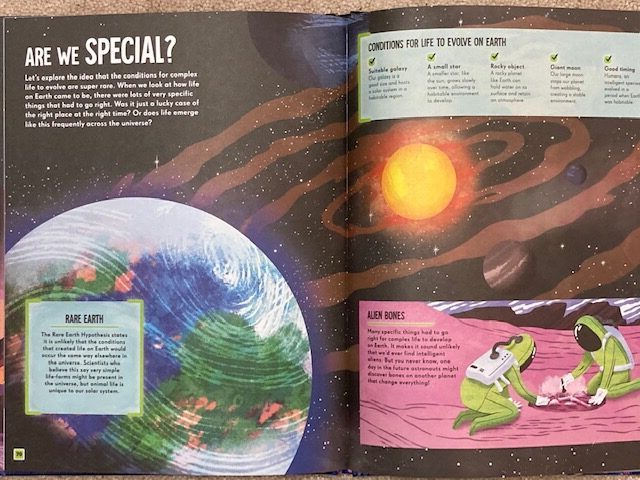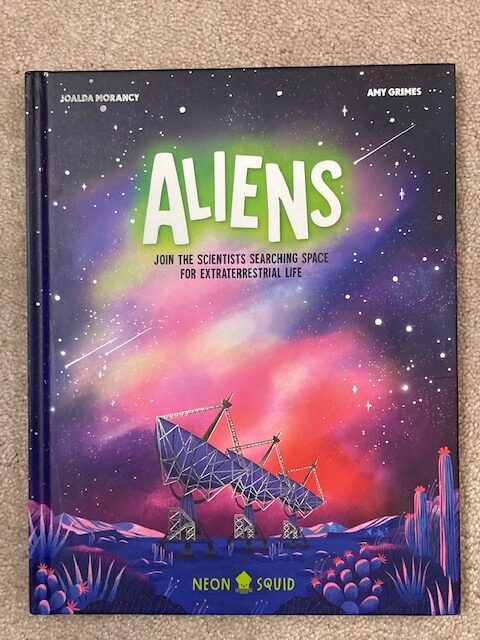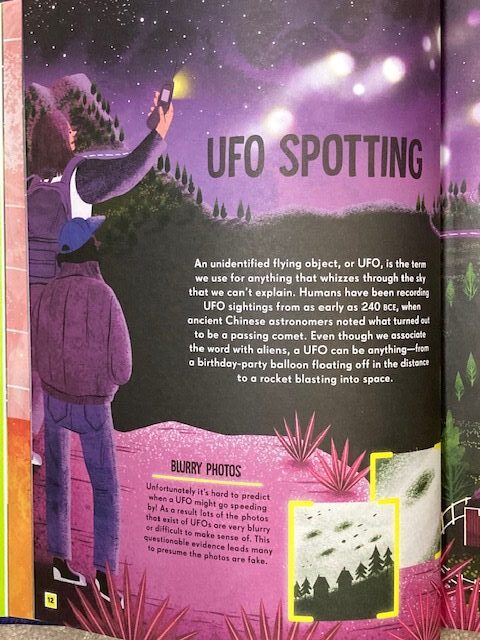Illustrated books can also be reference books. Aliens is one that fits in that category, although given its subject title and alluded subject matter you’re right to be suspicious. The key to where upper-elementary students will get the most from the book is in the book’s full title. Aliens, Join The Scientists Searching For Extraterrestrial Life is more about the science-based aspects around aliens, rather than the green basketball-playing men in our imagination.
Of course, the book offers a couple of pages dedicated to how tall green people came to personify aliens. It was in the late 1930s, UFO spotting was rampant, abductions were reported and flying saucers came to be a key component in pop culture and entertainment. Each element on those six pages is complimented with subdued tones and realistic, age-appropriate illustrations for those 7-12. The text offers enough information for those kids to discover a little bit about the phenomenon that Steven Spielberg and James Cameron brought to the big screen with perfection.
As readers dig into Aliens they’ll discover that it’s more about us going to other worlds, than other visitors coming here. We are the aliens. Thus, if humans are the ones who don’t belong, what conditions or what places could be possible places for us to inhabit and who could we possibly encounter along the way?
The Drake Equation was established in 1961 as an equation to hypothesize the possible number of alien worlds out there. The dwarf planet Ceres hides out in the asteroid belt in our solar system and has the most water that’s not on Earth. NASA sent Dawn, a probe to Ceres in 2015, but it didn’t find any signs of life. We created dozens of satellites, some that never even left the Earth, that was designed just to listen for extraterrestrial communications.
Exoplanets, the small moons that revolve around them, the ships needed to take us places and so much more are explored in Aliens. The TRAPPIST-1 system is especially exciting because it has seven planets that are roughly the same size as ours and also has water. This system is 40 light-years away from us, yet is the most studied solar system outside of ours. Aliens is jammed with blurbs and text paragraphs that will make kids think and hopefully encourage curiosity.
The only disconnect in the book is that some kids will pick it up hoping for a Bigfoot or alien expose, a la, The Truth is Out There. This book is not as salacious as that topic. Instead, it takes the more scientific, STEM route and examines what is required for us to be there. Of course, a by-product of that is how the conditions in those worlds would need to be in order for us to live and eat.
Because the book is presented in a format that elementary ages can digest, it aligns itself with reference books. Kids can skip to any page, excluding those six that are devoted to aliens, and discover something fascinating about a close by the alien world, its environment and neighbors. Every page is loaded with illustrations that are entertaining, without being too pandering or babyish for those ages. That also allows younger middle school students who are studying the solar system to learn from the book.
An older person reading a book that younger audiences can enjoy offers up a great chance for everyone to learn. The older one realizes that the younger generation can digest, enjoy and learn from it, so they’ll raise their game. Those older readers will also realize that Aliens is more about the process, than the actual green men that might garner most of the interest.
Aliens, Join The Scientists Searching Space For Extraterrestrial Life is by Joalda Morancy with illustrations by Amy Grimes and is available on Neon Squid books which is distributed by Macmillan Publishers.
There are affiliate links in this post.








 Facebook
Facebook Twitter
Twitter Flickr
Flickr GooglePlus
GooglePlus Youtube
Youtube